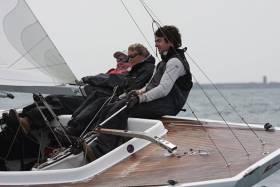Displaying items by tag: Neil O'Hagan
Neil O’Hagan Talks Tall Ship Plans, Enda’s Vendée Globe Challenge & More At Greystones SC Next Week
#SailingTalk - The next event in Greystones Sailing Club’s Winter Wednesdays series of talks hosts Neil O'Hagan of the Atlantic Youth Trust, the project that aims to bring about Ireland's next sail training tall ship.
O’Hagan is also on-shore co-ordinator for Kilcullen Team Ireland in the Vendée Globe, and he will have all the scuttlebutt on the highs and lows of Enda O’Coineen sailing Kilcullen Voyager, Ireland’s first entry in the round-the-world solo yachting challenge.
The date for diary is next Wednesday 25 January at 8pm, bar open from 7.30pm. You won’t want to miss it!
Tall Ships & Sail Training – Ireland's Atlantic Youth Trust Will Give It A Different Spin
#tallships – Rugged sailing in romantic tall ships; the camaraderie of the sea; character development. It's an inspiring combination which has gripped maritime nations for more than a century as sail has given way to more utilitarian sources of power. First there was steam. Then steam in turn was superseded by diesel and even nuclear power. And with each stage, there has been a remorseless drive towards reducing manning levels.
So what on earth is there now to occupy people who, in a former era, might have found a meaningful role in life as crew on board a sailing ship? For with each new development in shipping, we realise ever more clearly that large sailing ships were one of the most labour-intensive objects ever created.
However, we don't need to look to the sea to find areas of human activity where technological development has made human input redundant, and large sectors of the population largely purposeless. It's the general social malaise of our time. So for many years, the majority of maritime countries have found some sort of solution by an artificial return to the labour-intensive demands of sailing ships.
But in an increasingly complex world with ever more sources of distraction and entertainment, does the established model of sail training still work as well as it once did? W M Nixon meets a man who thinks we need a new vision for best using the sea and sailing ships to meet the needs of modern society's complex demands.
Tall Ships and Sail Training........They're evocative terms for most of us. Yet the buzzwords of one generation can surprisingly quickly become the uncool cliches of the next. That said, "Tall Ships" has stood the test of time. It's arguably sacred, with a special inviolable place in the maritime psyche.
So when we see a plump little motor-sailer bustling past with some scraps of cloth set to present an image of harnessing the wind's timeless power, we may be moved to an ironic quoting of Robert Bridges: "Whither, O splendid ship......" But somehow, citing Masefield's "a tall ship and a star to steer her by" would seem to be beyond the bounds of even the worst possible taste.
There's a simple purity about "Tall Ships". It works at every level. Google it, and you'll find the academics claim that it became official with its use by John Masefield in 1902 and Joseph Conrad in 1903, though Henry David Thoreau used it much earlier in 1849. But Conrad being the benchmark of most things maritime in academia, 1903 seems to be set in stone.

We all know what is meant by a true Tall Ship, but as these rig profiles indicate, the proliferation of sail training programmes has led to an all-inclusive approach
Yet at the vernacular level, it has been there much longer than any of them. There's a bit of maritime meteorological lore which our academics would probably dismiss as vulgar doggerel, but I've found it still moves me. When far at sea, with the underlying swell increasingly in evidence and the weather conditions which it describes clearly developing overhead, inevitably you'd remember this little couplet:
"Mackerel sky and mare's tails,
Make Tall Ships carry low sails".
It's not Yeats. But when you're on a formerly blue sea now turning grey and far from anywhere in a 25-footer, it's a little thought which can still make the hairs stand up on the back of your neck. And it's that mention of "Tall Ships" which gives it the added resonance. So things stand well with the phrase "Tall Ships". But what's the word on the continuing viability of "Sail Training"?
"I'm fed up with the constant use of the term "Sail Training". It's bandied about so much it has become meaningless. And always talking about "Sail Training" limits the scope of what we're trying to do. If we could find some useful phrase to replace "Sail Training", but something which is also more visionary than the very pedestrian "Youth Development" which is sometimes replacing it, then maybe we could go a long way to capture the imagination both of our potential supporters, and of the young people we hope will want to come aboard the ship".
The speaker is Neil O'Hagan, busy Executive Director of the Atlantic Youth Trust, which is actively developing ways and means of building a 40 metre sailing ship which will serve all Ireland in a wide variety of functions. And as he has immersed himself in this challenging project when he is clearly a very able person who could name his price in many roles in high-paying large corporations, it behoves us to pay attention.
We have been skirting the AYT and its project several times here recently. But as we gradually emerge from the recession and see what is still standing, for some reason with every passing week we find it ever more disturbing that the Irish Sail Training Brigantine 84ft Asgard II was lost nearly seven years ago by foundering, and the Northern Ireland Ocean Youth Trust's 60ft ketch Lord Rank was lost after striking a rock five years ago.
Far from being swept under the carpet, it's a double whammy which has to be faced and dealt with as 2015 rolls on with the biggest Tall Ships assembly ever seen in Ireland coming to Belfast, and not an Irish Tall Ship worthy of the name to represent us.

The popular image of Tall Ships is a crowded port with a fun-filled crowd...............
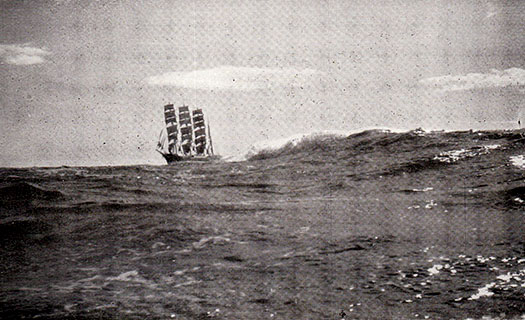
.....yet for many old salts, the true image is the lone ship at sea, going about her business. This photo of a four-masted barque was taken from a small cruising boat in the 1930s
But an ideas-laden shooting of the breeze with O'Hagan soon shows that we're going to have to learn to think a long way out of the box before we begin to meet the demanding expectations of this man and his board of trustees and directors, and the much-anticipated presence of the Tall Ships in Belfast is only a trigger to help activate a much more complex vision. Neil O'Hagan hopes not only to be instrumental in the creation of a new Irish sailing ship, but he also hopes to change the way in which we perceive such a vessel, and our expectations of the way she will be used.
In our initial blog on this back on January 17th, we thought we were making a tellingly adverse point in suggesting that the barquentine Spirit of New Zealand - which the AYT reckons will provide the best model for the development of their project – is not so much a sail training tall ship as we know it, but rather, with her large complement of 40 "trainees", she's more of a floating schoolship which happens to set sails.
Far from being blown out of the water by this "damning" criticism which I and others had voiced, O'Hagan was delighted that we'd lit upon this aspect of the plan. "Old-fashioned sail training has had its day" he says. "When education authorities and social service bodies and welfare funds and philanthropic organisations are looking for some way to provide interesting, satisfying and ultimately long-term-beneficial experiences for young people of all backgrounds and varying states of mental health including the very happily normal, they expect a much broader curriculum than is provided by the traditional sail training model".
"And come to that, so do the young people themselves. If sailing is genuinely their great leisure interest, they'll be into it already at a personal level among like-minded friends. But if they're more typical young people of today, they'll have a wide range of interests, and during the ten day cruises which we hope to make the backbone of the new ship's programme, the sailing will only be part of it."
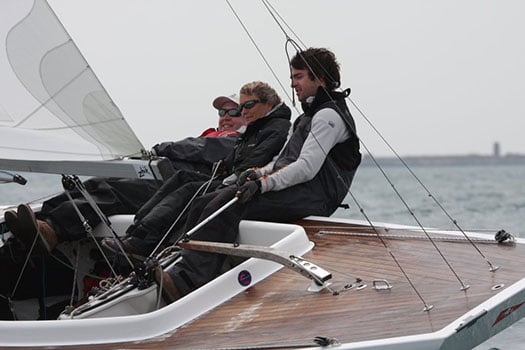
Away from the day job - Neil O'Hagan helming a Dragon
Its not that O'Hagan is anti-sailing. Far from it – he has been seen in the thick of things in the midst of the International Dragon Class in recent years. But a good liberal education with time in the Smurfit Business School in UCD and extensive family links all along Ireland's eastern seaboard north and south, plus direct business experience in both Dublin and Belfast, give him a breadth of vision to provide the AYT with a real sense of purpose.
The Atlantic Youth Trust has been quietly building itself since it emerged from a representative workshop researching the building of a sailing ship for Ireland, held in Dublin Port in the Spring of 2011. From that, a Steering Group of Lord Glentoran and Dr Gerald O'Hare from the north, and Enda O'Coineen and David Beattie from the south – all of whom had worked together before on other north-south youth sailing projects – was set up, and they commissioned a professional consultancy group – CHL Consulting of Dun Laoghaire – to work with them in producing a Vision & Business Plan, which eventually ran to 96 detailed pages.
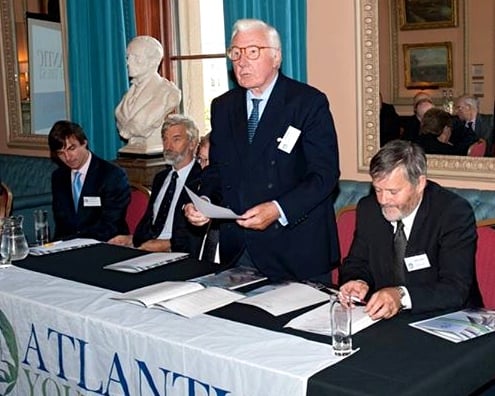
The Chairman Lord Glentoran (Gold Medallist at the 1965 Winter Olympics) at the AGM of the Atlantic Youth Trust with Executive Director Neil O'Hagan (left), Sean Lemass and Director Enda O'Coineen (right)
In due course, the Atlantic Youth Trust emerged with Olympic Gold Medal veteran Lord Glentoran as Chairman. And with Neil O'Hagan as Executive Director, the show was on the road with the detailed worldwide investigation of 25 successful educational schemes involving sailing ships - note we've dropped that "sail training" tag already. And in New Zealand they found something that was really new, something that fell in with their view that the double loss of the Asgard II and the Lord Rank provided an opportunity for a truly fresh look what a national sailing ship might be and do.
It's an extraordinary place, New Zealand - particularly from a maritime point of view. Far from seeing their isolation as a drawback, they use it as an advantage for fresh thinking. And they don't cling to time-hallowed ways brought over from "the old country". On the contrary, being in a new country is seen almost as an imperative for trying new ways and ideas, hence they're at the sharp end of top events like the America's Cup.
And as they were far from the fleets of established tall ships in Europe and America, with the Spirit of New Zealand they had to develop new ways of using a vessel which would spend much of her time cruising their own extensive and very varied coastline on her own, distant from the Tall Ship sailfests which are such a feature of the programme in the more compact and crowded parts of the world.

Spirit of New Zealand is barquentine-rigged
Thus by geographic necessity. New Zealand is ahead of the curve in developing ways of contemporary validity in the use of large sailing ships. We all hear of what a marvellous party the Tall Ships will activate in Belfast, just as they've done before in Dublin, Cork and Waterford. But hold hard just a moment. Isn't sail training aimed at young people mostly between the ages of 15 and 25? Surely their central involvement in vast open air quayside parties - with the inevitable underage alcohol intake possibilities – is totally at variance with the healthy idealism of the concept?
For sure, the organisers of modern Tall Ships Festivals go to enormous effort to ensure that they're genuinely family-friendly events. But the ancient traditions of sailors in port can be difficult to escape. So when you've a proposed programme which is essentially based on recruitment through continuing contact with secondary schools and similar age cohorts – as is the case with the Atlantic Youth Trust project – then it becomes increasingly desirable to have a ship which is large enough to be self-sufficient, with a viable way of onboard life built around large shared areas, such that the traditional waterfront-oriented harbour visits will no longer be such an important part of the cruise programme.

Splendid isolation. Spirit of New Zealand in an anchorage remote even by New Zealand standards
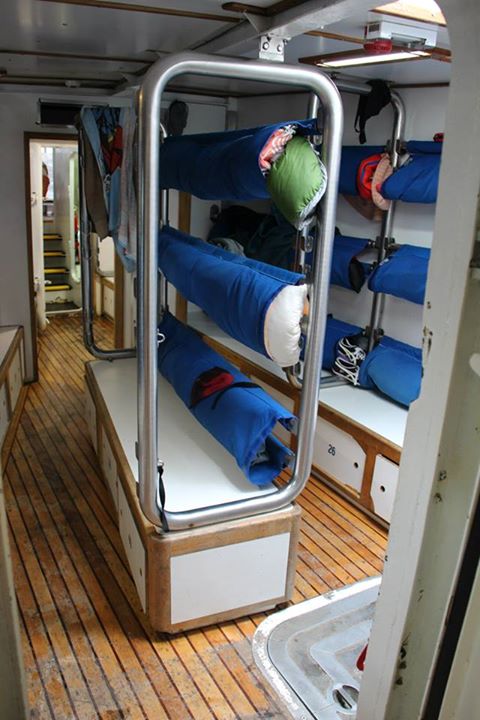
Packing them in....as she carries a crew of 40 trainees, and with space required for extensive communal areas, Spirit of New Zealand's bunks are efficiently planned
Of course the new vessel will take part in Tall Ships Races and Tall Ships Festivals, and of course she'll make the occasional ambassadorial visit, both along the Irish coast and abroad. But with the underlying philosophy of the ship being largely self-sufficient of shoreside distractions other than when they're environmentalist and educational ventures, sometimes with an expeditionary element, then the more gregarious aspects of her yearly routine will be kept well in perspective, and everyone will be the better for it.
As it's essentially a cross-border venture, equal funding from the two governments – each of which it is hoped will put up 30% of the capital expenditure - is anticipated, and with a fresh tranche of Peace Process money on the horizon, the resources are gradually building as people get used to the idea. There has also been much technical background research, and leading naval architects Dykstra of The Netherlands are on the case with an impressive scenario, for as Trustee and Director David Beattie has put it, this one isn't going to be cobbled together, it's going to be a "best in class project".
As the planned use of the vessel is essentially civilian, she will be Ireland's sailing ship without being the national sailing ship. There's more than a slight difference to the Asgard situation. In many other countries, the most impressive tall ships are part of the naval service, but in Ireland we have a Naval Service sailing vessel already, she is the ketch Creidne which was the national sail training vessel between the decommissioning of the first Asgard in 1974 and the commissioning of Asgard II in 1981. In recent years, she has had a major refit and is now actively sailed, but as Ireland's Naval Service is so essentially Cork-based, the Creidne is very much part of the scene in Cork Harbour and the Naval Base at Haulbowline.
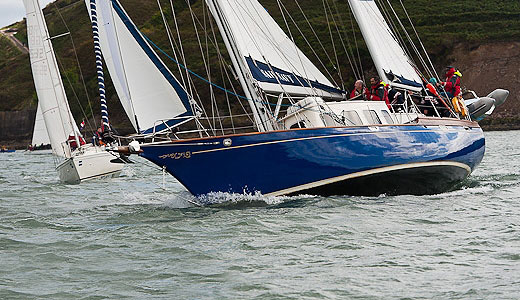
The Naval Service have Creidne for sail training purposes for their own personnel. Photo: Bob Bateman
In fact, although the Atlantic Youth Trust does have a Cork element to it, and advisers include several leading figures in the Cork marine industry, the reality is that it is first and foremost a cross-border enterprise between offices in Dublin and Belfast.
This means that Cork – which is the true capital of maritime development in Ireland, and I mean that in all seriousness – is an associate port to the Atlantic Youth Trust project, rather than a central pillar of it. But I don't think the people of Cork would wish to have it any other way. When I was in the southern capital for the fund-raiser for the new National 18 class development a month or so ago, Class President Dom Long kicked off proceedings by explaining how it was the Corkonian sense of independence which had inspired the mighty leap in National 18 design. He did this by showing a map which neatly illustrated the Cork sailor's view of Ireland.

The Cork sailor's view of Ireland
It says everything. But I don't think the Atlantic Youth Trust should lose any sleep over the fact that they might be seen as being on a Dublin-Belfast axis from which Cork is as usual going its own sweet way. 'Twas ever thus. And anyway, in the end the Corkmen will probably provide many of the officers for the proposed new vessel to which we wish, on this fine Easter Saturday morning, the very fairest of fair winds.
#tallship – With St Patrick's Day almost upon us, the westward trek across the Atlantic in search of American benevolence and funding for worthy objectives can become a very crowded pilgrimage. Among those looking for meaningful support for their pet projects, there will likely be proponents of some sort of new Tall Ship to replace the much-mourned brigantine Asgard II, and the ketch Lord Rank, both of which foundered in 2008 to leave Ireland - north and south alike - bereft of national sail training vessels.
Since then, there have been re-groupings of those who support the admirable concept of sail training for young people. In all, there may be as many as five different bodies on the island of Ireland which now provide access to the international programme. Coiste an Asgard itself was wound up in 2011, but it was immediately re-born as the Dublin-headquartered Sail Training Ireland, the national authority which carries the imprimatur of Sail Training International, the global body which co-ordinates and regulates all sail training.
The other main organisation, often functioning in tandem with Sail Training Ireland, is the Atlantic Youth Trust. It has offices in both Dun Laoghaire and Belfast, and has as its primary objective the construction and commissioning – for all Ireland – of a Class A 40-metre three-masted barquentine. WM Nixon continues with the story.
When we carried a history and analysis of Ireland's involvement with the International Tall Ship and Sail Training movement on this site on January 17th, the immediate response was formidable, and in favour. It continues to register hits at a rate which shows that the maritime community in Ireland has a real wish to see our own proper tall ship.
To achieve this ambition, in terms of having a clearly outlined plan the Atlantic Youth Trust is way ahead. With leading personnel from many parts of Ireland on its high-powered board of Trustees and Directors, the concept - originally inspired by Enda O'Coineen and John Killeen of Galway – is already becoming very complete.
Executive Director Neil O'Hagan and other have researched globally in order to analyse the success of more than two dozen national sail training schemes, and they have concluded that the best model to learn from is the Spirit of Adventure Trust in New Zealand, which functions through training based around the barquentine Spirit of New Zealand, which at 45.2 metres in "sparred length" is steel built registering at 184 gross tons, and carries 40 trainees.
The funding concept on the capital outlay for building the new ship for Ireland will ultimately rely on a total of €15 million being put up jointly by the two governments in the interests of inter-community and cross-border co-operation. Although the current turmoil in the Northern Ireland political administration might temporarily impair the onward progress of the plan, it seems to have a certain inevitable momentum, and highly-regarded Netherlands-based Dykstra Naval Architects have been retained on the project, as have their associates at Damen Shipyards, who may supply the vessel in flatpack form for final construction in Ireland.
As to running costs, the AYT point out that it will come out of current spending, as the vessel by nature of its work will be able to tap into government funds for social welfare and other youth schemes.
Faced with such a juggernaut of ideas, energy, contacts at top government level, and sheer enthusiasm, it seems churlish to question the validity of what is, after all is said and done, a magnificent project. But there are many in Irish sailing in general and sail training in particular who are concerned about the thinking on which it is all based.
To begin with, while we all admire the maritime spirit of New Zealand, does it make sense to draw conclusions for Ireland from a successful scheme in what is essentially a very isolated island nation? Ireland may be an island nation, but it's clearly wide of the mark to describe us as isolated, and this is reflected in the pattern of tall ships visit. If just six tall ships turn up at one port in New Zealand, it's regarded as a major event. But if less than sixty tall ships turn up at this year's Tall Ships Festival in Belfast at the beginning of July, then it will be regarded as a non-event.
In other words, Spirit of New Zealand usually functions in relative isolation, so it is not sail training as we know it in Europe. In fact, she is more of a floating school cum boot camp which happens to set sails, and in order to keep her very numerous trainee complement of 40 busy, while cruising in New Zealand waters (which she does nearly all the time), she is escorted by a large rib which frequently conveys the trainees ashore for land-bound ventures which sometimes out-balance their sea time.
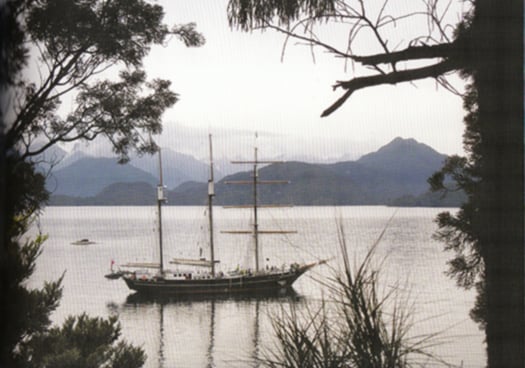
Alone, all alone.....the Spirit of New Zealand in a remote inlet on New Zealand's South Island. With forty trainees and a relatively easily-handled rig, she has a programme whch includes much shoreside activity. Photo courtesy STI
It's a very attractive programme in the New Zealand context, as they have many remote coastal areas which are virtually uninhabited and ripe for shore adventures which will not conflict with the rights of local inhabitants. But in Ireland and much of Europe such a programme would immediately meet problems, and for Ireland it makes more sense to follow the European pattern which puts an almost total emphasis on voyaging and sail training races.
Were a heavily-crewed vessel such as Spirit of New Zealand to do the European programme, there simply wouldn't be enough work for the 20 trainees on each watch to keep them happily occupied for long periods. Ideally, trainee tall ships are extremely labour-intensive for all hands, and in Europe that's the way it is done, but it needs what amounts to individual attention for each trainee.
So it's difficult to escape the conclusion that one reason for the attraction of the New Zealand scheme for the Atlantic Youth Trust is that it wins out in the numbers game. Forty young people taken out of troubled and aimless environments ashore, and sent away together on a voyage, is an impressive amount of social problems temporarily sorted in one fell swoop.
But will it be as behaviourally beneficial, in the long term, as it would be for a smaller number of people on a smaller and busier vessel? It will vary from case to case, but generally you'd reckon that the smaller more personal crew setup, with each trainee more directly involved in the sailing of the ship, would produce better results, while always remember that having as much square rig as possible is central to the concept.
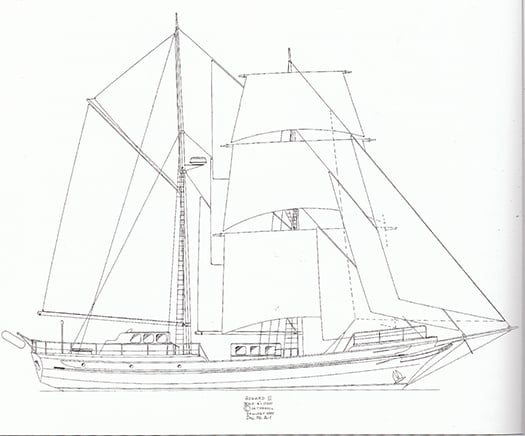
A timeless design which remains a very viable proposition for an easily managed ship which keeps her crew busy. Jack Tyrell's lines for Asgard II would lend themselves to construction in steel or even aluminium.
Ideally, to see Ireland's Tall Ship-owning reputation restored, many of us would like to see not just one newly-built replica of the 84ft brigantine Asgard II being launched, but three – one each for Cork, Dublin and Belfast. For, at the moment, the main axis of Atlantic Youth Trust activity seems to be between Dublin and Belfast. Yet as last weekend's National Annual Sailing Awards ceremony in Dublin so clearly underlined, Cork is really where it's at in terms of maritime development, and the lack of a significant Cork element seems to be a weakness of the AYT scheme.
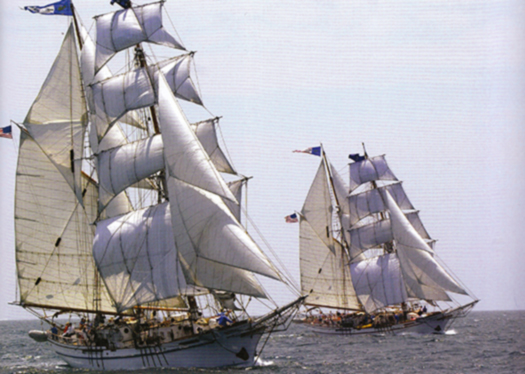
Might this be the way forward? One of our suggestions today is that Ireland really needs three Asgard IIs, based in Cork, Dublin and Belfast. We get an idea of how it might look with the two sister-ship American brigantines Exy Johnson and Irving Johnson, which are based in Los Angeles in California, where they were built in 2002.
Nevertheless, it says much for the dedication and energy of those promoting the Atlantic Youth Trust that we have the luxury of debating the validity of their plans, which have been so thoroughly developed. We may disagree with their conclusion, but it's not total disagreement – an Irish version of Spirit of New Zealand would be a very emphatic improvement on our present ship-less state, which is too much of a reflection of an ancient and negative mind-set.
Every time you see the Tall Ships gather and see how maritime countries of population comparable to Ireland, such as Norway, Denmark and Portugal, can send forth spectacularly handsome Tall Ships, it becomes a painful reminder of how the new Irish Free State increasingly turned its back on the sea.
The fact was admitted by Minister for the Marine Simon Coveney at last week's National Sailing Awards Ceremony in a speech which hinted at some very significant developments in the Irish maritime sphere in the near future.
But really, what Minister Coveney was talking about is that it is time and more for us to grow up in our attitude to the sea. When the Free State was struggling into being in 1922, the popular view was that British power was synonymous with sea power. So if you were against the sea and seafaring in all its manifestations, then you were demonstrating the purity of your patriotism through adopting what was essentially if subconsciously an anti-British stance. Childish perhaps. But we all know that's the way it was.
So despite the flurry of maritime enthusiasm which was engendered by national emergency during World War II to inspire the creation of Irish Shipping and the Maritime Inscription, what this meant was that when the underlying attitude genuinely began to change in the 1950s, a positive attitude towards the sea wasn't being built upwards from Ground Zero. It was being built from Ground Minus Thirty – the number of years that an anti-maritime attitude had been the unstated yet very real official policy.
Thus there was a period when Irish maritime enthusiasm had to be kept going almost as a secret cult, and I'd an odd reminder of this some weeks back at the annual Awards Ceremony of Sail Training Ireland. The Patron of STI is President Higgins, and the event was held – for the second year running – in the Mansion House in Dublin. Yet the very fact of the identity of their Patron, and of their event being staged in the Mansion House in the presence of Lord Mayor Christy Burke, provided such pleasure and pride for everyone in the gathering that it was a forceful reminder that, not so very long ago, seafaring was very much the poor relation in Ireland, and there were those in authority who would have happily air-brushed it out of the national picture entirely, leaving it to foreign crews to undertake the rough trades of the sea.
But thanks to those former members of Coiste an Asgard who refused to give up the vision of sail training for Ireland, even as the onset of economic Armageddon from 2008 to 2011 made any prospect of a new Asgard II a very distant vision as the government chucked the €3.8 million insurance payout into the bottomless pit of national debut, Sail Training Ireland arose like a Phoenix and set in place sail training bursaries for places on foreign tall ships, using international contacts built up during the 27 successful Asgard II years to ensure that Ireland could re-build our position at the heart of the movement.
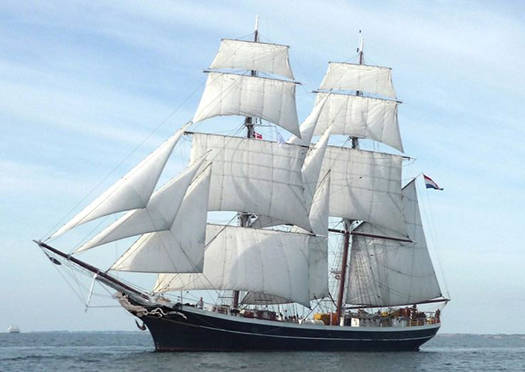
She keeps them busy....the Dutch brig Morgenster is superbly labour-intensive in the best sail training traditions. Photo courtesy STI
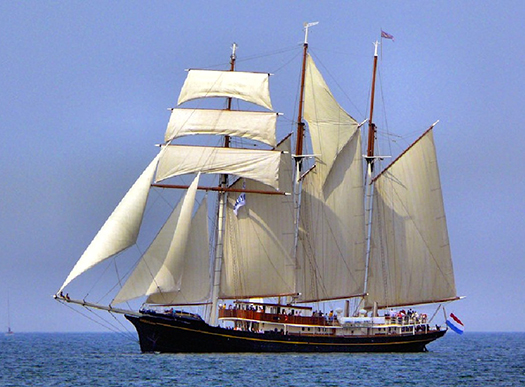
Gulden Leeuw is another of the Dutch Tall Ships which have been taking Irish trainees to sea on Sail Training International programmes. Photo: Courtesy STI
The thriving tall ships scene in the Netherlands – which has become a focal point for sail training and the Tall Ships industry for all Europe – proved the most fruitful placement area, with most Irish trainees being positioned aboard the very handsome 48 m (sparred length) brig Morgenster, which has become a familiar sight in Irish ports. Another ship well used is the three-masted topsail schooner Gulden Leeuw, a long slim craft as she is 70 m in sparred length, while that noted poster girl of Tall Ships sailing, the 56 metre three masted Dutch barque Europa, also carried Irish crew from time to time.
However, while placements on such vessels work very well, the hankering for an Irish sail training flagship is always there, and fortunately in recent years Oliver Hart's 70ft training schooner Spirit of Oysterhaven has been punching way above her weight in filling the role in gallant style with a varied programme on the Irish coast.
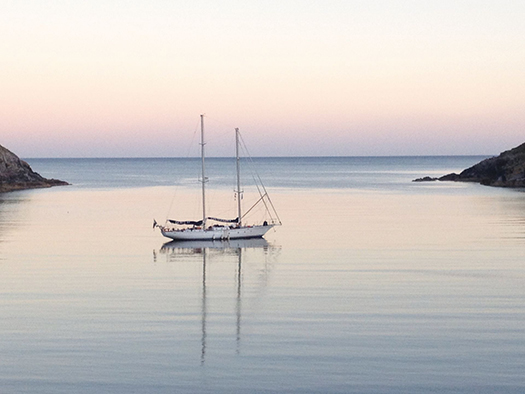
Spirit of Oysterhaven in South Harbour, Cape Clear Photo: Oliver Hart
This and much more was reflected in the Sail Training Ireland Awards Ceremony in the Mansion House, a goodly gathering which was representative not just of every possible aspect of sail training at home and abroad, but also of Irish ports which are increasingly interested in an activity which brings their ancient waterfronts vividly to life. And the progress of various ship projects was spoken for by everything from complete vessels such as the Basque Spanish schooner Atyla represented by Rodrigo de la Serna, through vessels in the making as personified by our own ketch Ilen. She has since seen her final new plank knocked ceremonially into place at Oldcourt in Baltimore, but here's an evocative video Gary MacMahon left with us of the creative planking process under way. And present too was Neil O'Hagan of Atlantic Youth Trust, whose organisation deservedly received recognition for their pioneering work towards a completely new ship.
{youtube}ZLT3D8TBbwk{/youtube}
The main awards presented in the Mansion House by STI Chairman Seamus McLoughlin, who is former Head of Operations for Dublin Port, were:
1. Trainee of the year: Andrew Crowley
2. Special Contribution Award: Turlough Kennedy
3. Special Achievement Award: Fiona Armson
4. Perpetual Asgard Award: For an outstanding contribution to, or achievement in Sail Training by an individual or group: Atlantic Youth Trust / Foroige Group of Trainees
5. Watch-leader of the Year: Sara Mason
6. Volunteer of the year: Jonathan O'Brien
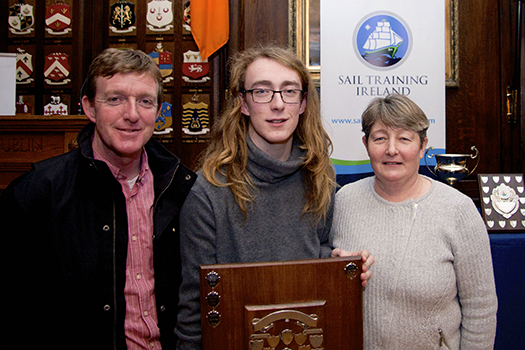
Trainee of the Year Andrew Crowley with his parents in the Mansion House
Trainee of the Year Award: Andrew Crowley
Andrew is Club Captain of the Spirit of Oysterhaven Trust. During 2014, he was instrumental in helping to organise the Club's sailing trips aboard Spirit of Oysterhaven with a special emphasis on providing opportunities for young people with disability. He helped to organise the Club's Youth in Action programme, and crewed aboard Spirit during the Irish Cruising Club's sponsored Anniversary voyage from Glandore to Glengariff with a crew of eight trainees, including several with disability. During the summer Andrew was a vital member of a short-handed crew delivering Spirit from Oysterhaven to Glandore during which he proved himself an outstanding active crew member.
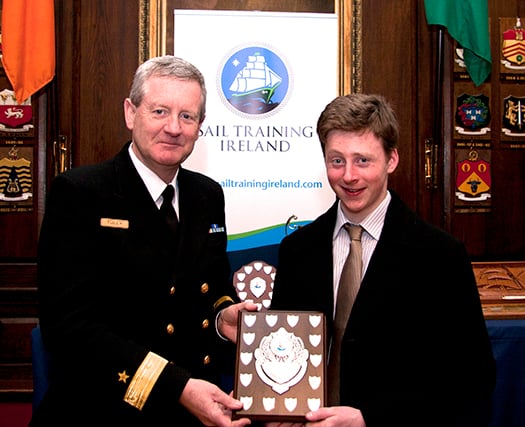
Commodore Hugh Tully, Flag Officer Commanding Naval Service, with Turlough Kennedy, who received the Special Contribution Award
Special Contribution Award: Turlough Kennedy
This year's special contribution award goes to Turlough Kennedy from the lakeside port of Scarriff in County Clare for the outstanding role he filled on the Dutch tall ship Morgenster.
To quote Michael Byrne, Director of Sail Training Ireland: "This contribution was not only recognised by us. On completion of last year's voyage Turlough - despite his limited sea going experience - was offered a crew member's berth on board the ship by the Captain. While he was not in a position last year to take up this offer for the remainder of the 2014 season, in 2015 we are delighted that Turlough will be sailing as voluntary crew on board the Morgenster. The following is a short note from the ship's Captain, Harry Muter: "Turlough sailed with us last year and he was very good good both in the sailing department as in the social processes. For his age he was surprisingly adult, patient and emphatic. And then the music, it coloured this voyage, and Turlough played a role with his complicated bagpipe and improvisation talent. Looking forward to sail with him again." " (There are no prizes for guessing that "complicated bagpipes" are Uileann Pipes).
Special Achievement Award: Fiona Armson
The special achievement award this year went to Fiona Armson for the tenacity and determination she showed by completing her 14 day voyage. Fiona found some aspects of life at sea a real challenge but despite being given several opportunities by her leaders and the crew to take on a lighter work load Fiona refused to leave her watch and pushed on.
Fiona completed her voyage having never missed a single watch or duty and, in a way that would put a smile on any sailor's face, she sailed the Gulden Leeuw into her home port of Bangor.
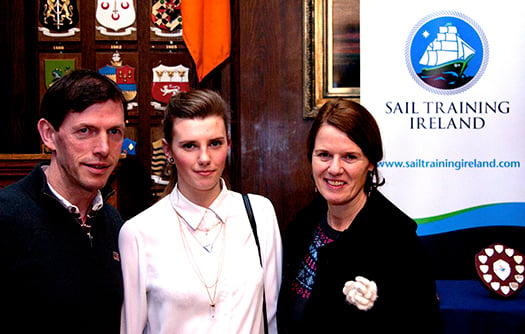
Special Achievement Award Winner Fiona Armson with her parents
Perpetual Asgard Award
Awarded to a group of four Foroige Trainees: Michael Collins, Dean Mc Keon, Brandon McDonagh, and Daniel O'Halloran,
In March 2014, four young people from Ballybane in Galway set out on a remarkable adventure, travelling half way around the world to experience the Spirit of Adventure's 10-Day Youth Development Voyage in New Zealand. Three youth workers accompanied the group for the three week trip, and one of them, Pearse O'Toole, was at the Mansion House with them. The trip was funded by a private donation and managed by the Atlantic Youth Trust and Foroige.
The group spent 10-days sailing around the magnificent Hauraki Gulf off Auckland on the barquentine Spirit of New Zealand. They adapted very well to their new surroundings as crew members and returned with fresh skills, more confidence than ever, and a new outlook on life and what is possible.
Neil O'Hagan, Executive Director of the Atlantic Youth Trust, followed this award with a presentation about the Peace and Reconciliation Fund-supported Sea-Connections scheme, and then the next award was remarkably appropriate, as it was for the Watch Leader of the Year and it went to Sara Mason for her very successful participation in an EU Youth Exchange Voyage on Gulden Leeuw.
Sara (pronounced saarah) is from the North Island of New Zealand, but now lives and studies in Dublin. She is part of the Shackleton Outdoor Adventure Management Diploma Course in Colaiste Dhulaigh in Coolock. She joined the team of youth leaders which facilitated the main voyage programme of Youth Exchange projects in May-June. As a leader on the Dutch Ship Gulden Leeuw, she cared for and facilitated a group of 40 young adults over a 14 day period. She was an outstanding support to them as a leader, and brought with her a set of skills that are unique to professionals who spend their lives working with people in the outdoor adventure industry. She also has a fantastic energy and enthusiasm and was an inspiration to the trainees and other leaders.
Volunteer of the Year Award - Jonathan O'Brien
Jonathan has become involved in a multitude of voluntary activities with Sail Training Ireland in the last year. In 2013 he volunteered as a youth leader for one of STI's youth exchange voyages for 10 days from Belfast to Dublin. In 2014 he was head-leader across youth exchange voyages with a total of 8 leaders, with at times up to 100 trainees across three ships seeking his support.
Having a background in both outdoor education and in social care, Jonathan has an exceptional set of skills that lend themselves very well to the role of leader on a tall ship, and he has now found himself "volunteered" for a position on STI's sub-committee for trainee programmes. During 2014, he also spent time on a number of ships across Europe, while somehow also fitting in a spell serving as First Mate on the Spirit of Oysterhaven. He is helping to develop on-board programmes for a number of STI's funded voyage schemes during 2015, and will also train STI's group of twelve youth leaders in April.
So the good work goes on, but the more of it there is, the more it become apparent that Ireland needs her own tall ship, and the sooner the better. A programme of international placement may work very well for those in the know, but for people down the country which are remote from maritime communities, it often takes the stimulus and sense of pride engendered by an Irish ship to make that first move afloat.
It was summed up so well by investigative academic and journalist Dr Elaine Byrne in our story about the Tall Ships on January 17th that it deserves repeating here. Usually in her line of work, Elaine Byrne takes no prisoners. But the quiet depth of feeling underlying the brief story of how the Byrne family from the deepest rural depths of County Carlow became involved in sail training has a resonance for us all today:
"I'm the oldest of seven children from a farming family on the Carlow/Wicklow border, where the household income is augmented with a funeral undertaking business attached to a pub in which I might still work on visits home. Our background is just about as far as it's possible to be from Ireland's maritime community. Yet thanks to Asgard II, I was able to take a step into the unknown world of the high seas as a trainee on board, and liked it so much that over the years I spent two months in all on board, graduating through the Watch Leader scheme and sailing in the Tall Ships programmes of races and cruises-in-company.
Down in the depths of the country, my new experiences changed the family's perceptions of seafaring. Four of my siblings then had the opportunity to sail on Asgard II. If it were not for Asgard II, my family would never have had the chance to sail, as we did not live near the sea, nor had the financial resources to do so. The Asgard II played a large role in our family life as it became a Rite of Passage to sail on board her. My two youngest siblings did not sail on Asgard II because she sank, which they much regret.
Apart from the discipline of sailing and the adventure of new experiences and countries, the Asgard II brought people of different social class and background together. There are few experiences which can achieve so much during the formative years of young adulthood".
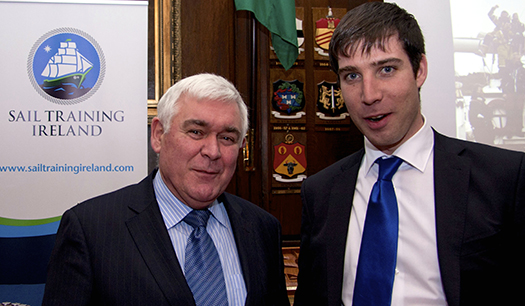
Seamus McLoughlin, Chairman of Sail Training Ireland, with Michael Byrne, Director.

Carolanna Foley, awarded a Drogheda Port Sail Training Bursary, with Seamus McLoughlin (left) and Commodore Hugh Tully
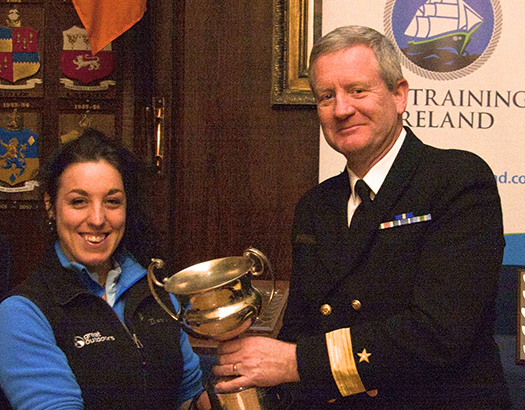
Sara Mason, Watch Leader of the Year, with Commodore Hugh Tully

Jonathan O'Brien (left) Volunteer of the Year, with Oliver Hart
- Sagres
- Tall ship
- Coiste an Asgard
- Atlantic Youth Trust
- barquentine
- Sail Training Ireland
- Sail Training International
- John Killeen
- Enda O'Coineen
- Neil O'Hagan
- Dykstra
- Damen Shipyard
- sailing
- Simon Coveney
- Lord Mayor
- Phoenix
- Spirit of Oysterhaven
- Europa
- Morgenster
- Gulden Leeuw
- Basque Spanish schooner Atyla
- Ilen
- Elaine Byrne
- Oysterhaven
- Mansion House
- Christy Burke
- World War II



























